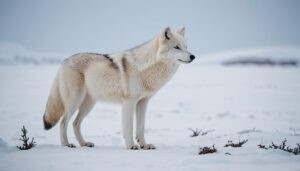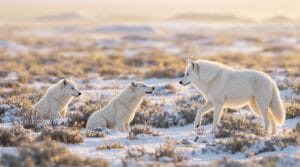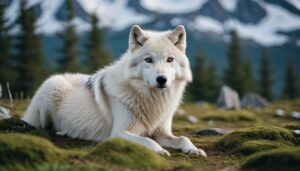Introduction
The Arctic wolf, a majestic apex predator, plays a crucial role in the Arctic tundra’s ecosystem
This article explores how the Arctic wolf’s position at the top of the food chain influences its environment and the importance of its conservation. We’ll delve into the wolf’s impact on prey populations, vegetation, and other predators, and examine the various threats it faces, including climate change and human activities
Additionally, we will discuss ongoing and future conservation efforts aimed at preserving this vital species and ensuring the ecological balance of its habitat
The Arctic Wolf’s Role in Its Ecosystem
The Arctic wolf (Canis lupus arctos), also known as the white wolf or polar wolf, is a subspecies of the gray wolf native to the Arctic regions of North America. As an apex predator, the Arctic wolf plays a pivotal role in maintaining the balance and health of its ecosystem
This section delves into the Arctic wolf’s ecological significance, focusing on its prey species, hunting patterns, and the broader impact on prey populations and other predators
Prey Species and Hunting Patterns
Arctic wolves primarily prey on a variety of animals including muskoxen, Arctic hares, caribou, lemmings, and birds
Their diet can vary significantly depending on the availability of prey, which is influenced by seasonal changes and environmental conditions. These wolves exhibit highly adaptable hunting strategies, often hunting in packs to take down larger prey such as muskoxen and caribou
The cooperative hunting behavior of Arctic wolves is a critical aspect of their role as apex predators. By working together, they can efficiently hunt large and potentially dangerous prey, which solitary hunters could not tackle. This pack behavior not only ensures a higher success rate in hunts but also supports the survival of the pack by providing sufficient food resources
Impact on Prey Populations
The Arctic wolf’s hunting activities have significant implications for the population dynamics of their prey species
By preying on the old, weak, and sick individuals, wolves help maintain the genetic health and vitality of prey populations. This natural selection process ensures that only the strongest and most fit individuals survive and reproduce, promoting the overall health of the species
Moreover, the predation pressure exerted by Arctic wolves keeps prey populations in check, preventing overgrazing and subsequent depletion of vegetation. For instance, in the absence of wolves, caribou populations could increase to unsustainable levels, leading to overconsumption of vegetation and a potential collapse of the ecosystem
The presence of Arctic wolves thus helps maintain a balance between prey populations and the availability of vegetation, ensuring the sustainability of the habitat
Influence on Other Predators
As apex predators, Arctic wolves also have a significant influence on other predators within their ecosystem
They often compete with and sometimes prey on smaller carnivores such as Arctic foxes. By controlling the populations of these smaller predators, Arctic wolves indirectly protect the populations of smaller prey species, which might otherwise face increased predation pressure
Furthermore, the presence of Arctic wolves can lead to a phenomenon known as “mesopredator release.” In ecosystems where apex predators are absent, mesopredators (mid-ranking predators) often experience population booms due to the lack of top-down control
This can result in increased predation on smaller prey species and potential disruptions in the ecosystem. By maintaining their role at the top of the food chain, Arctic wolves help prevent such imbalances, preserving the stability and biodiversity of their environment
Ecological Impact of the Arctic Wolf
The ecological impact of the Arctic wolf extends beyond its immediate role as a predator. By influencing various aspects of their habitat, these wolves play a crucial part in maintaining the delicate balance of the Arctic ecosystem
This section examines how Arctic wolves affect vegetation and the overall habitat balance, highlighting their broader ecological significance
Effects on Vegetation
Arctic wolves indirectly impact vegetation through their regulation of herbivore populations. By preying on species such as caribou and muskoxen, wolves help control the grazing pressure on vegetation. Without this predation, herbivore populations could grow unchecked, leading to overgrazing and significant degradation of plant communities
Overgrazing can have several detrimental effects on the Arctic landscape. It can lead to soil erosion, reduce the diversity of plant species, and hinder the regrowth of critical vegetation
This, in turn, affects other wildlife that depends on these plants for food and habitat. By keeping herbivore numbers in balance, Arctic wolves ensure that plant communities remain healthy and resilient, supporting a diverse range of species
Research has shown that in areas where wolves are present, the diversity and abundance of plant life are generally higher compared to areas where wolves have been extirpated. This highlights the crucial role that top predators play in promoting biodiversity and ecosystem stability
Maintaining Habitat Balance
The presence of Arctic wolves contributes to the overall balance and stability of their habitat. Through their predation, wolves create a cascade of ecological effects that benefit the entire ecosystem. This phenomenon, known as a trophic cascade, underscores the importance of apex predators in maintaining the structure and function of their environment
For example, the hunting activities of Arctic wolves can create carcasses that provide food for scavengers such as ravens, Arctic foxes, and bears
This availability of carrion supports a variety of species that might otherwise struggle to find sufficient food, particularly during the harsh winter months. In this way, wolves help sustain a network of species, contributing to the overall biodiversity and resilience of the Arctic ecosystem
Moreover, by controlling the populations of herbivores and smaller predators, Arctic wolves help prevent these species from becoming overly dominant. This prevents any single species from monopolizing resources and allows for a more even distribution of food and habitat among various organisms. This balance is crucial for maintaining the health and functionality of the ecosystem, ensuring that no single species overwhelms the environment
Studies on trophic cascades have demonstrated that the removal of apex predators can lead to significant ecological imbalances. In Yellowstone National Park, for instance, the reintroduction of gray wolves led to a resurgence of vegetation and a return to a more balanced ecosystem. While the Arctic ecosystem is different, similar principles apply, and the presence of Arctic wolves is vital for maintaining ecological harmony
Threats to the Arctic Wolf Population
The Arctic wolf faces numerous threats that jeopardize its survival and, by extension, the health of the Arctic ecosystem. These threats primarily stem from climate change and human activities, which have profound and often interconnected impacts on the wolves and their habitat
This section explores these threats in detail, highlighting the urgent need for effective conservation measures
Climate Change
Climate change poses one of the most significant threats to the Arctic wolf. The Arctic region is experiencing warming at nearly twice the global average rate, leading to drastic changes in the environment. These changes include the melting of sea ice, thawing of permafrost, and alterations in the distribution and availability of prey species
The loss of sea ice and the resulting changes in the landscape can disrupt the wolves’ hunting patterns and access to prey. For instance, as the ice melts, prey species such as caribou and muskoxen may migrate to new areas in search of suitable habitat and food, making it more challenging for wolves to find and hunt them
Additionally, the shrinking ice cover can limit the wolves’ movement across their range, isolating populations and reducing genetic diversity
Moreover, warming temperatures can lead to a mismatch in the timing of biological events, such as the birth of wolf pups and the peak availability of prey. This temporal misalignment can result in lower survival rates for wolf pups, further threatening the population
A study published in Nature Climate Change in 2020 highlighted that the Arctic’s warming trend could lead to a significant decline in the population of Arctic wolves by the end of the century if current trends continue unchecked. This underscores the critical need for global efforts to mitigate climate change and protect the fragile Arctic ecosystem
Human Activities
Human activities also pose substantial threats to the Arctic wolf. As human presence in the Arctic increases due to activities such as resource extraction, shipping, and tourism, wolves face new challenges that threaten their survival
One of the most direct threats from human activities is habitat destruction. Industrial activities, such as mining and oil and gas exploration, can lead to the fragmentation and degradation of the wolves’ habitat. This not only reduces the available space for wolves to live and hunt but also disrupts the delicate balance of the ecosystem by introducing pollutants and altering the landscape
Increased human presence also raises the risk of direct conflicts between wolves and humans. For example, as humans encroach on wolf territory, wolves may come into closer contact with human settlements, leading to potential conflicts over resources
In some cases, wolves may prey on livestock, prompting retaliatory killings by humans. This can have devastating effects on local wolf populations, which are often small and isolated
Furthermore, the expansion of infrastructure, such as roads and pipelines, can create barriers that impede the movement and migration of wolves and their prey. These barriers can isolate wolf populations, reducing genetic diversity and making them more vulnerable to disease and other threats
Another significant concern is the impact of increased tourism in the Arctic. While tourism can bring economic benefits to the region, it can also disturb the natural behavior of wildlife, including Arctic wolves. The presence of tourists can lead to habitat disturbance, pollution, and increased stress on wildlife, all of which can negatively affect wolf populations
Conservation Efforts for the Arctic Wolf
Given the array of threats facing the Arctic wolf, conservation efforts are crucial to ensure their survival and the health of the Arctic ecosystem. This section outlines current conservation measures and explores research and future strategies aimed at preserving this vital apex predator
Current Conservation Measures
Several conservation measures are currently in place to protect the Arctic wolf and its habitat. These measures involve both direct actions to safeguard wolf populations and broader efforts to preserve the Arctic environment:
Protected Areas: One of the primary strategies for Arctic wolf conservation is the establishment and management of protected areas
National parks, wildlife reserves, and other conservation areas provide safe havens where wolves and their prey can thrive with minimal human disturbance. Notable examples include the Arctic National Wildlife Refuge in the United States and various protected areas in Canada’s northern territories
International Agreements: Conservation of the Arctic wolf also relies on international cooperation, given the transboundary nature of their habitat
Agreements like the Arctic Council and various bilateral treaties between countries such as Canada, the United States, and Greenland focus on protecting Arctic wildlife and ecosystems. These agreements facilitate collaborative research, monitoring, and conservation initiatives
Legal Protections: Many countries within the Arctic wolf’s range have enacted laws and regulations to protect wildlife
For instance, the Endangered Species Act in the United States provides legal protection for species at risk, including the Arctic wolf, ensuring that any actions that could harm these animals or their habitat are carefully regulated
Community Involvement: Involving local and Indigenous communities in conservation efforts is essential
These communities often have extensive traditional knowledge and a vested interest in the health of the ecosystem. Collaborative projects that integrate traditional knowledge with scientific research can lead to more effective and culturally appropriate conservation strategies
Research and Future Strategies
Ongoing research and innovative strategies are vital for the long-term conservation of the Arctic wolf. These efforts focus on understanding the wolves’ ecology, monitoring population trends, and developing adaptive management practices to address emerging threats:
Ecological Research: Scientific studies aimed at understanding the Arctic wolf’s role in the ecosystem, their hunting behavior, and their interactions with other species are critical. Research initiatives often involve tracking wolf movements using GPS collars, studying their diet through scat analysis, and monitoring prey populations. This data helps inform conservation strategies and management decisions
Climate Change Adaptation: Given the profound impact of climate change on the Arctic environment, developing strategies to help Arctic wolves adapt is a priority. This might include identifying and protecting critical habitats that are likely to remain stable as the climate changes, as well as enhancing connectivity between habitat areas to facilitate migration and gene flow
Mitigating Human Impact: Reducing the negative effects of human activities is another key focus. This can involve implementing stricter regulations on industrial activities, promoting sustainable tourism practices, and designing infrastructure projects that minimize habitat fragmentation. Efforts to mitigate human-wolf conflicts, such as the use of non-lethal deterrents to protect livestock, are also important
Public Awareness and Education: Raising awareness about the importance of Arctic wolves and the threats they face is crucial for garnering public support for conservation efforts. Educational programs, documentaries, and outreach initiatives can help build a broader understanding of the need to protect these animals and their habitat
Innovative Technologies: Advancements in technology offer new tools for conservation. For example, the use of drones for monitoring wildlife, genetic analysis for understanding population health and diversity, and remote sensing to track environmental changes are all promising areas of research that can enhance conservation efforts
Conclusion
The Arctic wolf plays an indispensable role in maintaining the balance and health of the Arctic ecosystem. As an apex predator, it regulates prey populations, supports vegetation health through trophic cascades, and influences the behavior of other predators. However, this crucial species faces significant threats, primarily from climate change and human activities, which disrupt its habitat and food sources
Conservation efforts are vital to safeguard the Arctic wolf and, by extension, the entire Arctic ecosystem. Current measures include establishing protected areas, enforcing legal protections, and engaging in international cooperation
Involving local and Indigenous communities in these efforts ensures that traditional knowledge complements scientific research. Future strategies must focus on addressing climate change impacts, mitigating human disturbances, and leveraging innovative technologies to monitor and support wolf populations
Protecting the Arctic wolf requires a comprehensive approach that integrates ecological research, adaptive management, and public awareness. By understanding and mitigating the threats these wolves face, we can help preserve the delicate balance of the Arctic environment and ensure the continued survival of this majestic predator











